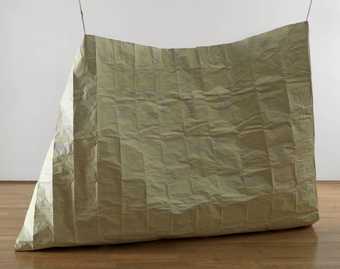I’m Karla Black, and I make sculpture, and this is my studio in Glen Quaich. I’ve got as piece of work in the watercolour exhibition.
The piece in this show is a sculpture. It’s a hanging sculpture; it’s made from cellophane with various different kinds of paint on it. It’s got acrylic paint, emulsion paint, and some watercolour, as well as other materials like toothpaste, some lip gloss, and nail varnish. That might be true – the nail varnish bit! I can’t remember what’s on it, it’s got all kinds of things. It might have, like, shampoo and like, hair gel and things like that, but I just can’t remember. I should have looked at the materials list!
With any watercolour you can get so many different effects, then it’s like so many different kinds of paint, but you are just using the one substance, so just depending on how much water I used with the watercolour paint on the cellophane surface, you know, at times it’s completely see-through, just a hint of colour, and then at other times I would use it with hardly any water at all, and you’d get quite a build-up, quite a form. And then I could continually sort of water it down in grades to really, sort of, see what could be done with that colour.
This is the beginnings of a piece of work that I’m making for the Venice Biennale, and it will eventually become a very tall, layered sculpture that looks a bit like a cake.
This is an experiment with plaster powder when it’s been sieved onto the floor, and then thrown into the plaster are these things called bath bombs. It has once been perfect, then it’s been in some way, sort of, damaged I suppose, and then in some way, repaired; so that whatever has happened there has become part of its overall character.
I just work out of my unconscious and out of my own desires – and say, I want to do that, I want to do that – and so I do. And then I try to think about what I’ve done. I don’t want it to be just pure gesture. In a way, that’s just a sort of acting out of something – in a way, that’s a self-indulgence, to think that’s enough, to not work back into it. So in a way I suppose I have to work back into it like a painter. It’s a really formal way of working – it’s really just thinking about aesthetics in an abstract sense, and always thinking about just the composition and the relationships between form and colour. That’s really painterly, I think, that, you know, that’s what a painter does. In the end, I’m bringing that sensibility and that process into sculpture, and it’s not like it’s a painted sculpture, you know. That whole process of painting, then, is the sculpture.


